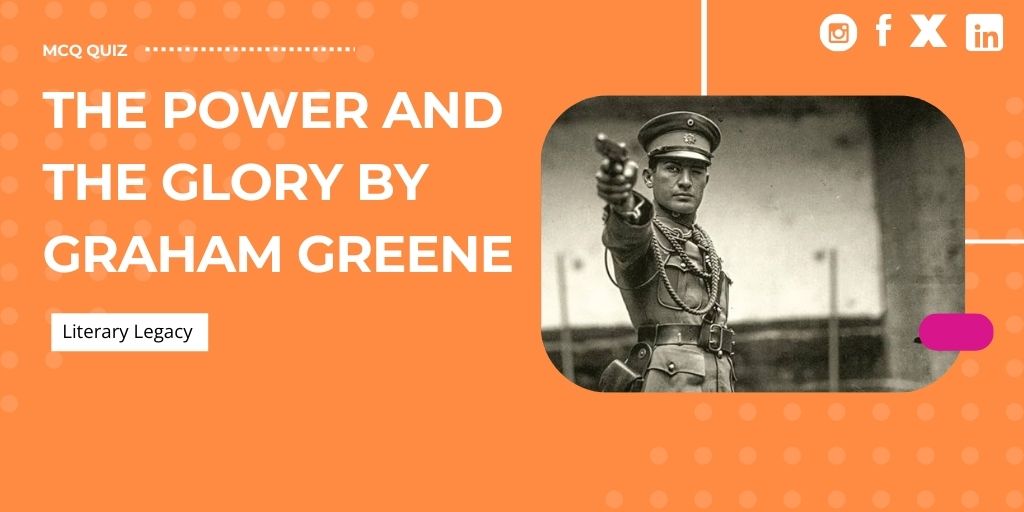1. What happens to the priest after he meets the mestizo in jail?
Choices
A) He is allowed to go free.
B) He decides to turn himself in to the authorities.
C) He is recognized and taken to another jail.
D) He becomes a leader among the prisoners.
Answer: (A)
He is allowed to go free.
Despite multiple encounters, the priest is unrecognized by the lieutenant and is allowed to leave.
2. What is the priest’s emotional state throughout his journey?
Choices
A) He feels empowered and invigorated.
B) He is constantly filled with joy and hope.
C) He is mostly indifferent and unaffected.
D) He is fatigued and drained of the will to live.
Answer: (D)
He is fatigued and drained of the will to live.
The priest often feels exhausted and struggles with his purpose and will to live.
3. Why does the lieutenant pursue the priest?
Choices
A) He has a personal vendetta against him.
B) He wants to eradicate the Church and its influence.
C) He believes the priest has committed a crime.
D) He wishes to convert him to his beliefs.
Answer: (B)
He wants to eradicate the Church and its influence.
The lieutenant’s deep-seated hatred for the Church fuels his relentless pursuit of the priest.
4. What does the mestizo reveal about his character?
Choices
A) He empathizes with the priest’s situation.
B) He is a generous friend who aids the priest.
C) He is fiercely loyal to the priest.
D) He is untrustworthy and seeks personal gain.
Answer: (D)
He is untrustworthy and seeks personal gain.
The mestizo appears calculating and untrustworthy, often looking to betray the priest for profit.
5. What does Coral Fellows do during her encounter with the priest?
Choices
A) She offers to help him escape.
B) She becomes an emotional anchor for her family.
C) She expresses disdain for his priesthood.
D) She demands he leave her property.
Answer: (B)
She becomes an emotional anchor for her family.
Coral is portrayed as responsible and takes charge of her family, showing emotional strength.
6. What does the priest fail to do the night before his execution?
Choices
A) He finds peace and repentance for his sins.
B) He communicates with his congregation.
C) He formulates a plan to escape.
D) He speaks with the lieutenant.
Answer: (A)
He finds peace and repentance for his sins.
Despite his attempts, the priest struggles to repent for his sins before facing execution.
7. How does the lieutenant’s character evolve throughout the story?
Choices
A) He remains completely devoted to the law with no change.
B) He questions his beliefs but remains indifferent.
C) He becomes sympathetic towards the priest and the Church.
D) He loses his sense of morality and becomes increasingly ruthless.
Answer: (C)
He becomes sympathetic towards the priest and the Church.
Through discussions with the priest, the lieutenant shows signs of conflict and potential change.
8. How do the boy’s perceptions of the priest change by the end of the novel?
Choices
A) He sees the priest as a coward.
B) He wishes to speak with the priest.
C) He admires the priest and views him as a martyr.
D) He dismisses the priest’s actions as irrelevant.
Answer: (C)
He admires the priest and views him as a martyr.
The boy realizes the priest’s significance and regards him as a martyr for his faith.
9. What leads the priest to return across the border at the end of the story?
Choices
A) A desire to confront his enemies.
B) The hope of finding sanctuary.
C) The lure of revenge against the lieutenant.
D) The mestizo’s insistence to meet the gringo.
Answer: (D)
The mestizo’s insistence to meet the gringo.
The mestizo informs the priest that the gringo is dying and seeks confession, leading to his return.
10. What does the term ‘whiskey priest’ signify in relation to the protagonist’s identity?
Choices
A) A definition based on weakness
B) A scholar of theology
C) A representation of strength
D) A symbol of moral superiority
Answer: (A)
A definition based on weakness
The term ‘whiskey priest’ highlights the protagonist’s struggle with his identity and weakness.
11. What paradox is presented in the concept of Christian humility as discussed in the content?
Choices
A) Humility can be easily achieved with practice.
B) Feeling humble can lead to pride in one’s humility.
C) Humility is unrelated to one’s faith.
D) True humility comes from public recognition.
Answer: (B)
Feeling humble can lead to pride in one’s humility.
The priest realizes that striving for humility can paradoxically lead to pride.
12. What significant theme is illustrated by the relationship between the priest and the lieutenant at the end of the novel?
Choices
A) The possibility for mutual understanding
B) The strength of individualism
C) The inevitability of conflict
D) The isolation of the priesthood
Answer: (A)
The possibility for mutual understanding
Despite their opposing roles, the priest and lieutenant find qualified understanding of one another.
13. How does the lack of a defined name affect the priest’s character in the novel?
Choices
A) It enhances his authority as a priest.
B) It isolates him from forming relationships.
C) It allows him to hide his true identity.
D) It signifies his superiority over others.
Answer: (B)
It isolates him from forming relationships.
The priest’s lack of a name reflects his social isolation and uncertainty about his identity.
14. In what way does the priest’s experience of suffering relate to the concept of beauty?
Choices
A) Beauty emerges only in moments of joy.
B) Beauty and suffering are entirely unrelated.
C) Suffering can reveal life’s beauty.
D) Suffering is seen as purely negative.
Answer: (C)
Suffering can reveal life’s beauty.
The priest discovers beauty in life, particularly during times of great suffering.
15. Which of the following pairs are presented as seeming opposites in the content?
Choices
A) Strength and weakness
B) Good and bad
C) Love and hate
D) Beauty and truth
Answer: (C)
Love and hate
Love and hate are highlighted as interconnected rather than true opposites.
16. What reflects the priest’s uncertainty about his identity throughout the majority of the novel?
Choices
A) His lack of a solid name
B) His strong theological beliefs
C) His refusal to wear priestly garments
D) His acceptance of public recognition
Answer: (A)
His lack of a solid name
The priest’s lack of a firm definition and name signifies his existential uncertainty.
17. What common experience does Greene explore through the priest and the lieutenant?
Choices
A) The love of power
B) The struggle between faith and doubt
C) The pursuit of wealth
D) The rejection of societal norms
Answer: (B)
The struggle between faith and doubt
Both characters face inner conflicts related to their faith and moral choices.
18. What is Brigida’s relationship with the priest?
Choices
A) She is his niece.
B) She is his only pupil.
C) She is his illegitimate daughter.
D) She is a childhood friend.
Answer: (C)
She is his illegitimate daughter.
Brigida represents the priest’s illegitimate daughter, making their meeting tense due to their complicated relationship.
19. What leads Padre Jose to renounce his faith?
Choices
A) His desire to become a politician.
B) His belief that the church has become corrupt.
C) A forced marriage and the threat of execution.
D) The influence of his family.
Answer: (C)
A forced marriage and the threat of execution.
Padre Jose renounces his faith not out of conviction, but rather as a means of survival amid dire circumstances.
20. How does Mr. Tench’s character reflect the theme of spiritual deadness?
Choices
A) He constantly seeks self-improvement.
B) He is actively involved in community service.
C) He feels disconnected from his life and his wife.
D) He has a strong faith in religion.
Answer: (C)
He feels disconnected from his life and his wife.
Mr. Tench embodies spiritual deadness through his apathy and estrangement from the world around him.
21. What is the primary concern of the lieutenant in the novel?
Choices
A) Capturing the gringo for financial rewards.
B) Eliminating all forms of religion.
C) Bringing justice to those he views as obstacles.
D) Preserving historical accuracy.
Answer: (C)
Bringing justice to those he views as obstacles.
The lieutenant’s obsession with his idealistic vision leads to a crusade against what he perceives as obstacles.
22. What characterizes the disparity between Juan’s life and the priest’s experiences?
Choices
A) Juan lives a life of faith while the priest struggles with doubts.
B) Juan is depicted as cowardly, unlike the priest.
C) Juan’s life ends in betrayal while the priest remains loyal.
D) Juan has no religious beliefs, contrasting with the priest.
Answer: (A)
Juan lives a life of faith while the priest struggles with doubts.
Juan represents unwavering faith and composure, while the priest grapples with fear and the need for repentance.
23. What is Mrs. Fellows’ behavior indicative of?
Choices
A) A fear of death leading to neurotic behavior.
B) A strong belief in traditional values.
C) A commitment to supporting the priest.
D) An eagerness to engage in community events.
Answer: (A)
A fear of death leading to neurotic behavior.
Mrs. Fellows confines herself to her bed out of a deep-seated fear of mortality, showcasing her neurotic nature.
24. How does the priest’s perspective on suffering differ from that of the lieutenant?
Choices
A) He dreams of a perfect society without hardship.
B) He also harbors bitterness towards the world.
C) He seeks to eliminate all suffering for others.
D) He embraces suffering as part of life’s journey.
Answer: (D)
He embraces suffering as part of life’s journey.
The priest’s acceptance of suffering contrasts with the lieutenant’s idealism and subsequent frustration.
25. What role does Miss Lehr play in the narrative?
Choices
A) She is a force of pessimism in the story.
B) She embodies naive curiosity and innocence.
C) She is a skeptical critique of the priest.
D) She represents a practical approach to faith.
Answer: (B)
She embodies naive curiosity and innocence.
Miss Lehr’s curiosity and naivety highlight her as a character seeking understanding in a complex world.
26. What does the character of the jefe symbolize in the novel?
Choices
A) Strength in leadership and guidance.
B) Moral rigidity and adherence to authority.
C) Indifference to the struggles of others.
D) Indecision and lack of ambition.
Answer: (C)
Indifference to the struggles of others.
The jefe’s indifference to the priest’s plight exemplifies a lack of concern for the deeper human struggles.
27. What does the priest’s reaction to death reveal about his character?
Choices
A) He confronts death with peaceful acceptance.
B) He fears death and seeks to escape it.
C) He wishes to prolong his life at any cost.
D) He dismisses death as unimportant.
Answer: (A)
He confronts death with peaceful acceptance.
The priest’s acceptance of death illustrates a matured understanding of life’s inherent struggles.
28. Why is the priest in hiding at the beginning of the novel?
Choices
A) He is the last remaining clergyman in a state where religion is outlawed.
B) He has committed a crime.
C) He is trying to escape a rival religious faction.
D) He is being pursued for personal vendettas.
Answer: (A)
He is the last remaining clergyman in a state where religion is outlawed.
The priest is on the run because he is the last clergyman in a state that has prohibited religion.
29. What event causes the priest to miss his boat out of the city?
Choices
A) He engages in a heated argument.
B) He is called to a dying woman’s house.
C) He is arrested unexpectedly.
D) He gets lost in the city.
Answer: (B)
He is called to a dying woman’s house.
The priest is summoned to a dying woman’s house, which leads him to miss his scheduled boat.
30. Who is Brigida in relation to the priest?
Choices
A) His illegitimate daughter.
B) His sister.
C) His wife.
D) His childhood friend.
Answer: (A)
His illegitimate daughter.
Brigida is revealed to be the priest’s illegitimate daughter whom he meets in the village.
31. What does the lieutenant do when he arrives after the mass?
Choices
A) He leaves the village without suspicion.
B) He arrests the priest immediately.
C) He takes a hostage as a deterrent.
D) He calls for reinforcements.
Answer: (C)
He takes a hostage as a deterrent.
The lieutenant takes a hostage, claiming he will execute them if he learns the villagers have lied about the priest.
32. What character accompanies the priest, showing signs of being untrustworthy?
Choices
A) The lieutenant.
B) The mestizo.
C) The beggar.
D) Mr. Tench.
Answer: (B)
The mestizo.
The mestizo appears to be untrustworthy and has ulterior motives for following the priest.
33. What disguise does the priest use while trying to procure wine in the capital city?
Choices
A) A priest’s garb.
B) A soldier’s uniform.
C) A drill suit.
D) A common civilian’s apparel.
Answer: (C)
A drill suit.
The priest disguises himself in a drill suit to avoid detection while looking for wine.
34. What prevents the priest from obtaining wine as planned?
Choices
A) A state official confiscates it.
B) The seller runs away with his money.
C) The drinker consumes the entire bottle of wine.
D) He forgets his identity and is reported.
Answer: (C)
The drinker consumes the entire bottle of wine.
The man he meets consumes the entire bottle of wine the priest intended to use for mass.
35. What major decision does the priest make regarding entering Carmen?
Choices
A) He intends to challenge the authorities directly.
B) He chooses to avoid it to prevent capture.
C) He decides to confront the lieutenant there.
D) He plans to gather a group of clergy.
Answer: (B)
He chooses to avoid it to prevent capture.
The priest realizes that entering Carmen would likely lead to his capture, so he opts to avoid it.
36. How does the interaction with the beggar contribute to the plot?
Choices
A) It allows him to plan his escape.
B) It leads the priest to safety.
C) It introduces him to potential informants.
D) It shows the desperation of the poorest citizens.
Answer: (B)
It leads the priest to safety.
The beggar helps the priest by leading him to a hotel where he can procure wine.
37. What is the priest’s relationship with Maria?
Choices
A) They are distant relatives.
B) They had a brief affair.
C) They are completely unrelated.
D) They are childhood friends.
Answer: (B)
They had a brief affair.
The priest’s past connection with Maria is described as a brief affair in the village.
38. What is the primary source of conflict for the priest throughout the novel?
Choices
A) His quest for wealth and recognition.
B) His internal struggles with personal sin and guilt.
C) His desire to gain control over the Church.
D) His need for companionship and friendship.
Answer: (B)
His internal struggles with personal sin and guilt.
The priest grapples with his past sins and feelings of guilt as he navigates his challenges.
39. How does the priest ultimately achieve true humility?
Choices
A) Through recognizing his own weaknesses
B) By gaining respect from others
C) By abandoning his faith
D) By acting without regard for others
Answer: (A)
Through recognizing his own weaknesses
The priest attains true humility through his despair over his weaknesses and his inability to be truly humble.
40. What does Greene indicate about the nature of humility for a Christian through the priest’s character?
Choices
A) Humility is a simple trait that does not require self-reflection.
B) True humility is easily achieved through self-acknowledgment.
C) A Christian must always remain proud of their humility.
D) The pursuit of humility can lead to pride in one’s achievements.
Answer: (D)
The pursuit of humility can lead to pride in one’s achievements.
Greene portrays humility as a complex challenge, where the awareness of one’s achievements can paradoxically lead to pride.



